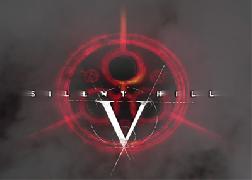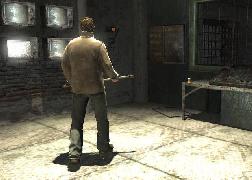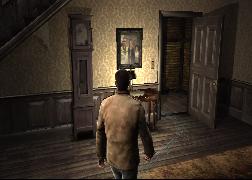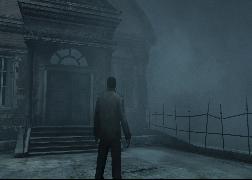Platforms: Xbox360, PS3
Release Date: 2008-09-30
Regions: USA Japan Europe
Chris’s Rating: ★★★☆
A game that can’t make up its mind which of the previous Silent Hill games it would like to emulate more, and suffers as a result.
Silent Hill Homecoming is the latest in a series of not-very-Silent-Hill-like Silent Hill games. I guess that’s not very fair; a better way to put it is, it’s the most recent in the line of mediocre Silent Hill titles that succeeded the absolutely brilliant three titles that began the series. Here’s a quick recap: the original Silent Hill game on PS1 is complex, unusual, technically stunning, and creepy as hell. Somehow Silent Hill 2 on PS2 actually outdoes its predecessor by taking all of those traits and making the story deeply personal. Then Silent Hill 3 came along and cranked up dials on other axes, mainly by making the protagonist have some personality and by making the Otherworld even more sinister than it was before. Three amazing games in a row.
Then begins what I call the Silent Hill Malaise. Silent Hill 4: The Room wasn’t intended to be a Silent Hill game, and it shows; the pacing is weird and the game missteps when it comes to interesting characters and sinister otherworlds. It’s not a bad game by any stretch of the imagination, it just doesn’t compare well to its predecessors. And then we get Silent Hill: 0rigins, a game so functionally similar to the first Silent Hill that you might not even realize that it was built by an entirely different team. But the missteps here are even greater; the character is a predictable amalgam of previous Silent Hill stoic everymen, and plot is little more than a thin excuse to run around classic Silent Hill locales. There’s nothing broken about the game per se–it’s just not all that interesting. Not only that, there’s a four year gap between Silent Hill 4 and Silent Hill 0rigins; quite a lag considering the first three games came out in a span of three years. The Silent Hill series thus finds itself in an unfocused, unreliable state; its games not exactly terrible but not really up to the stellar standard defined by the early games in the series either. It is during this time that ill conceived spin-off titles, such as the Silent Hill Shooting Arcade game arrive on the scene.
Enter Silent Hill 5, eventually renamed Silent Hill Homecoming, the next (and hopefully last) of the series’ Malaise games. It’s not really fair to lump it into the Malaise group without even telling you about it yet, but I’m going to do it anyway. I will say that, of the Malaise games, Silent Hill 5 is by far the closest to the standard set by Silent Hills 1 – 3. The team has tried very hard to capture the essence of the series, and while they are not always entirely successful, the effort really shows. Leah Alexander hailed the game as effectively straddling the needs of the series’ signature motifs and the requirement to meet modern game design standards, and I think that’s probably a fair assessment. It’s just that, in its attempt to be “more modern,” Silent Hill Homecoming occasionally falls prey to the same sorts of problems that damaged The Room and 0rigins: use of Silent Hill tropes without continuity or understanding of what those tropes were originally designed to do. Still, this is the most Silent Hilly Silent Hill game we’ve seen in years.
Homecoming, like 0rigins before it, tries to combine Silent Hill 2 and 3 to create a dual-purpose story line. On the one hand we’ve got a crazy (and, to tell you the truth, fairly boring and unbelievable) cult that is to blame for all the problems, but on the other hand it’s really a personal story about one man’s personal problems manifesting themselves as physical monstrosities. I played the whole game through and collected multiple endings and I am still not sure if the game wants me to believe that Alex, the protagonist, is personally tied to the horrific events he encounters or if he just happens to be a passing witness to some horrific religious accident. This competing focus saps a lot of the life out of both potential plot lines, but it’s still done much better than in 0rigins. The problem with Homecoming is that it can’t decide if it wants to be an explicit, violence-filled and easily explained story, or a subtle, suggestion-filled metaphor-laden story. These dueling influences take the punch out of the story that is there.
I’ve been pretty negative in this review so far, so let me back up for a second. The thing that Silent Hill Homecoming does really well is all of the tiny little details that go into making a Silent Hill game. It’s got good graphics, decent level design, very well-done enemies, and a much-improved combat system. The music and sound is, as always, fantastic, and the puzzles, while few and far between, are not half bad. The look and feel of the Otherworld is a particularly stand-out feature; in addition to rusted metal and barbed wire, the Otherworld in Homecoming is like an industrial furnace, with heat and flames pouring out from every crack–it’s really well done. When it comes to implementation details, Homecoming has it pretty much together; it innovates in small, important areas and leaves the rest well enough alone. If it wasn’t for the quality of execution on those little things, the entire game would fall apart.
But I have two big beefs with the game that I think keep it from breaking out of the Malaise group.
The first, as I mentioned after seeing the very first footage of this game, is the camera. The camera in Silent Hill Homecoming is just your standard, run-of-the-mill user-controllable 3rd person camera, and that’s a damn shame. It’s probably the right camera to have for the game’s improved combat system, but it’s a huge step backwards when it comes to traversal and exploration. Every previous Silent Hill game has had hand-tuned cameras; cameras that were fixed to splines, or stuck in place, or otherwise heavily controlled by the designers. The reason to limit freedom of camera movement is simple: it lets the game designers actually compose shots–you know, use cinematography–to make the game scary. Homecoming throws all of that right out the window, and as a result, it’s not scary at all. Seriously. This one design decision pretty much guts the horror factor from this game for me. The surrounding environments end up feeling like movie sets rather than actual places, and while it’s always easy to see where you are going, there’s never any tension or foreshadowing created by the camera. I was really disappointed to see the complex and mature camera system found in previous Silent Hill games replaced with this generic follow cam.
The second beef is with Homecoming’s game progression. In game industry terms, “game progression” means the movement from one stage to the next, and in this context I am talking specifically about pacing within the regular Silent Hill fog-descent-otherworld-boss challenge cycle. The narrative beats for Homecoming seem totally off; I complained about the placement of items and saves while playing the game, and now that I’ve finished it, I can’t say it ever got much better. The transitions and timing of the otherworld is all inconsistent too; sometimes the Otherworld shows up as a way to slowly ratchet up the tension as the boss approaches (which is how it was classically used in the non-Malaise times), and sometimes it just randomly appears before a particular fight and then randomly disappears after it. The pacing is off. Heck, even the transitions themselves are inconsistent; once or twice we’re treated to the neat paper tearing effect that was used in the Silent Hill film, and other times it just some lame fade-to-black-wake-up-in-hell sequence. In previous Silent Hill games the transitions to the Otherworld were extremely important beats in the narrative; they signified a change from the relative safety of the fog world to the no-holds-barred pants-wetting Otherworld.
This feeling of inconsistent pacing is (aside from the camera), the thing that feels most untrue to the series. Lots of other details have changed–the radio is pretty much gone and the film grain has be relegated to a shadow of its former self–but it’s the pacing and placement of weapons, saves, characters, cutscenes, and the Otherworld that break the classic mold most dramatically.
I have a few other complaints. The combat system is nice but not quite expressive enough to pull off the increased complexity that it’s offering. I found it very easy to get stuck in a take-hit-react-take-hit combo loop that is unbreakable until you get knocked back into a wall, and dodging only seem to work against certain types of enemies. The enemy balance is off–the Schisms and Smogs are way too hard and the Siams are way too easy. And the knife really is about 100 times more powerful than anything else in the game; I only ever used the guns for bosses. The game is unnecessarily gory–another aspect of the dueling influences I mentioned above. But these complaints are pretty minor; none of them ruin the game or feel as off-kilter as the pacing and camera issues.
And occasionally, the whole game comes together and everything clicks right into place. There’s one section in particular, named Hell Descent by the save file system, that is an almost perfect example of classic Silent Hill game play. The player transitions from the fog world into the otherworld, which is a long, maze-like descent punctuated by a few puzzles, and finally fights a cool-looking boss at the end before being deposited back in the fog world. It’s a simple sequence, but man, it’s my favorite part of the entire game. It’s right up there with Silent Hill 2 and 3 in terms of execution and pacing. If only the entire game were like that I would have nothing to complain about.
I think that Homecoming marks the end of the Silent Hill Malaise. It doesn’t have the problems of the other Malaise games, but it shows that a “regular” 3rd person game framework overlaid with Silent Hill tropes is not sufficient to duplicate the absolute quality of earlier games. To move forward from here, the series will have to go back to its roots or (more likely), forego the most common tropes and strike new ground in a completely different direction (which seems to be what Silent Hill: Shattered Memories is trying to do). Silent Hill Homecoming is more like the classic Silent Hill games than anything we’ve seen in years, and it was clearly built with a lot of care, but it just can’t live up to the standard set by the first three games. It’s not bad, just mediocre. A good transition point to bigger and better things. A sign that Silent Hill is back on the track of interesting, scary games.







